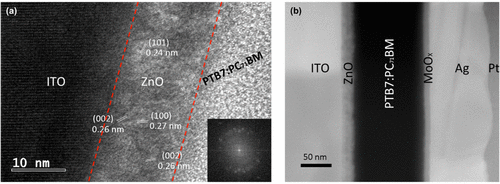当前位置:
X-MOL 学术
›
Cryst. Growth Des.
›
论文详情
Our official English website, www.x-mol.net, welcomes your
feedback! (Note: you will need to create a separate account there.)
Nanoscale Structure–Property Relationships in Low-Temperature Solution-Processed Electron Transport Layers for Organic Photovoltaics
Crystal Growth & Design ( IF 3.2 ) Pub Date : 2017-11-09 00:00:00 , DOI: 10.1021/acs.cgd.7b01222 Jiaqi Zhang , Maurizio Morbidoni , Claire H. Burgess , Jiaying Wu , Tian Du , Khallil Harrabi 1 , David J. Payne , James R. Durrant , Martyn A. McLachlan
Crystal Growth & Design ( IF 3.2 ) Pub Date : 2017-11-09 00:00:00 , DOI: 10.1021/acs.cgd.7b01222 Jiaqi Zhang , Maurizio Morbidoni , Claire H. Burgess , Jiaying Wu , Tian Du , Khallil Harrabi 1 , David J. Payne , James R. Durrant , Martyn A. McLachlan
Affiliation

|
Here we elucidate the nanostructure–property relationships in low-temperature, solution-processed ZnO based thin films employed as novel electron transport layers (ETLs) in organic photovoltaic (OPV) devices. Using a low-cost zinc precursor (zinc acetate) in a simple amine–alcohol solvent mix, high-quality ETL thin films are prepared. We show that at a processing temperature of 110 °C the films are composed of nanoparticles embedded in a continuous organic matrix consisting of ZnO precursor species and stabilizers. Using a combination of transmission electron microscopy (TEM) and X-ray photoelectron spectroscopy (XPS), we study the thermally induced morphological and compositional changes in the ETLs. Transient optoelectronic probes reveal that the mixed nanocrystalline/amorphous nature of the films does not contribute to recombination losses in devices. We propose that charge transport in our low-temperature processed ETLs is facilitated by the network of ZnO nanoparticles, with the organic matrix serving to tune the work function of the ETL and to provide excellent resistance to current leakage. To demonstrate the performance of our ETLs we prepare inverted architecture OPVs utilizing Poly[[4,8-bis[(2-ethylhexyl)oxy]benzo[1,2-b:4,5-b′]dithiophene-2,6-diyl][3-fluoro-2-[(2-ethylhexyl)carbonyl]thieno[3,4-b]thiophenediyl]] (PTB7): [6,6]-Phenyl-C71-butyric acid methyl ester (PC71BM) as active layer materials. The low-temperature ETL devices showed typical power conversion efficiencies (PCEs) of >7% with the champion devices achieving a PCE > 8%.
中文翻译:

低温溶液处理的有机光伏电子传输层中的纳米尺度结构与性能关系
在这里,我们阐明了低温,固溶处理的基于ZnO的薄膜中的纳米结构与性质之间的关系,该薄膜被用作有机光伏(OPV)装置中的新型电子传输层(ETL)。在简单的胺-醇溶剂混合物中使用低成本的锌前体(醋酸锌),可以制备高质量的ETL薄膜。我们表明,在110°C的处理温度下,薄膜由嵌入在由ZnO前体物质和稳定剂组成的连续有机基质中的纳米颗粒组成。通过结合使用透射电子显微镜(TEM)和X射线光电子能谱(XPS),我们研究了ETL中热诱导的形态和成分变化。瞬态光电探针显示,薄膜的混合纳米晶体/非晶性质不会导致器件中的复合损失。我们建议通过ZnO纳米颗粒网络促进低温加工ETL中的电荷传输,有机基体可用来调节ETL的功函数并提供出色的抗漏电流性能。为了证明我们的ETL的性能,我们使用聚[[4,8-双[(2-乙基己基)氧基]苯并[1,2-b:4,5- b '] dithiophene-2,6-diyl] [3-fluoro-2-[(2-乙基己基)羰基] thieno [3,4- b ] thiophenediyl]](PTB7):[6, 6]-苯基-C71-丁酸甲酯(PC 71 BM)作为活性层材料。低温ETL器件的典型功率转换效率(PCE)大于7%,而冠军级器件的PCE则大于8%。
更新日期:2017-11-09
中文翻译:

低温溶液处理的有机光伏电子传输层中的纳米尺度结构与性能关系
在这里,我们阐明了低温,固溶处理的基于ZnO的薄膜中的纳米结构与性质之间的关系,该薄膜被用作有机光伏(OPV)装置中的新型电子传输层(ETL)。在简单的胺-醇溶剂混合物中使用低成本的锌前体(醋酸锌),可以制备高质量的ETL薄膜。我们表明,在110°C的处理温度下,薄膜由嵌入在由ZnO前体物质和稳定剂组成的连续有机基质中的纳米颗粒组成。通过结合使用透射电子显微镜(TEM)和X射线光电子能谱(XPS),我们研究了ETL中热诱导的形态和成分变化。瞬态光电探针显示,薄膜的混合纳米晶体/非晶性质不会导致器件中的复合损失。我们建议通过ZnO纳米颗粒网络促进低温加工ETL中的电荷传输,有机基体可用来调节ETL的功函数并提供出色的抗漏电流性能。为了证明我们的ETL的性能,我们使用聚[[4,8-双[(2-乙基己基)氧基]苯并[1,2-b:4,5- b '] dithiophene-2,6-diyl] [3-fluoro-2-[(2-乙基己基)羰基] thieno [3,4- b ] thiophenediyl]](PTB7):[6, 6]-苯基-C71-丁酸甲酯(PC 71 BM)作为活性层材料。低温ETL器件的典型功率转换效率(PCE)大于7%,而冠军级器件的PCE则大于8%。











































 京公网安备 11010802027423号
京公网安备 11010802027423号